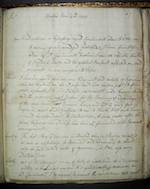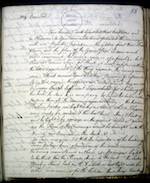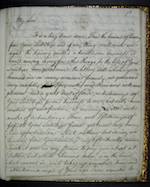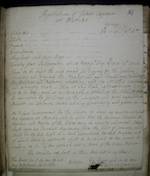With permission from the Royal Irish Academy, we are delighted to make available to the public some key documents relating to Charlemont’s Casino at Marino.
Click on the image of the document to access a full PDF which you can either read online or download to your own computer. Please acknowledge the Royal Irish Academy in any use of these documents. The letters and bill are organised by date below.

Letter from Mat[t]hew Peters to Thomas Adderley (June, 1758)
In 1734 Charlemont’s father died, and his mother Elizabeth Caulfeild (née Bernard) remarried. Thomas Adderley became Charlemont’s stepfather and, in the early 1750s, acted on his behalf at Marino. Charlemont was very interested in showcasing the latest techniques for productive garden design at Marino, and to this end arranged for Matthew Peters to travel around England, improving his knowledge of walls, fruit trees, and stoves. This is described in the letter. On Peters‘ return, he found the walls and trees neglected, and here expresses his distress.
Letter from Giovanni Battista Cipriani to the Earl of Charlemont (Friday 17th July 1767)
This letter refers to the five designs (Venus was revised) for the four attic statues that Cipriani designed for Charlemont, for the Casino. A translation is below.
My Lord, I didn’t touch with the pen the other figure of Venus, whose sketch I had the honour to show you, it not being different in the edge outline to that I formerly gave her along with the Ceres, and the Apollo, except a little in the left arm is lower and outstretched, therefore in the event that your excellency does not approve this design, the sculptor can easily amend [it]. In the meantime I presume to wish your Excellence a very happy journey and offer my very humble services and with profound respect give myself the honour of bowing… Your humble and devoted servant, GB Cipriani
Letter from William Chambers to the Earl of Charlemont (1768)
In 1768, six years after his plans for the ‘Egyptian Room’ were exhibited, Müntz was still producing designs for Charlemont, through Chambers’ commission. After a detailed discussion of plans for the Casino, its interior decoration still remarkably ongoing, Chambers wrote that I have seen Müntz and pressed him to finish your Lordship’s design several times. He says now your Lordship will have a sketch of it by next post. Both Casino and Gothic Room were externally complete five years previously, when the Countess of Northumberland visited. It is unknown which design by Müntz Chambers is referring to here.
Letter from Simon Vierpyl to Edward Murphy (1774)
This is a ‘threaded’ letter between Murphy and Vierpyl. Murphy instigated the communication, and Vierpyl wrote his reply on the same page below. It describes the collection of busts and statues that Vierpyl worked on for Charlemont in Rome; Murphy would like to know how much they are worth, and Vierpyl essentially replies that you cannot put a price on art or satisfaction.
Letter from Chambers to Charlemont (1779)
In this letter from Chambers to Charlemont, Chambers describes how he misses correspondence from Charlemont, and how he wishes he could travel to Dublin to see him, but that he is occupied with the building of Somerset House. He also reminds Charlemont of a bill which remains unpaid, and offers to send it again if Charlemont has forgotten it.
Bill from Chambers to Charlemont (1779)
This is the bill referred to above. It refers to directions and designs provided from 1773 to 1775, which remain unpaid. It is difficult to discern which building each item referred to, as Chambers completed work for both Marino House and Charlemont House, as well as the Casino. Referred to here are designs for flower stands, a drawing room ceiling, and a pedestal to hold an antique, among others.
Regulation of Future Expenses at Marino (c. 1780)
These three pages in Charlemont’s own hand give marvellous detail for how the demesne was run. Employees are listed, with their salaries. We learn that he hired a shepherd and two boys to care for the sheep that ornamented the parkland. The ‘Regulation‘ represents Charlemont’s plan for a more economic handling of his Marino estate; he was heavily in debt at this point in his life. Much of the responsibility for this new thrift was given to Mr Adams, the steward.
There are many other resources freely available online. These include:
- Property related to the Charlemont family on the Landed Estates Database.
- The tiny (7cm long) sketchbook by Anne Caulfeild (née Bermingham), 2nd Countess Charlemont, in the National Library.
- The Charlemont Album, a family sketchbook from around 1816 of views around the Marino Estate, in the Yale Center for British Art.






